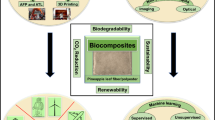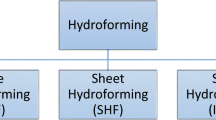Abstract
Injection moulding of micro structured polymer parts is often limited due to the replication quality of the structured surfaces. To enhance the replication quality process parameters, e.g., pressure, temperature or injection velocity, are adapted. Here, the mould temperature is the most important factor. This paper investigates the influence of the mould temperature on the replication of micro structured surfaces using amorphous and semi-crystalline polymers. Using rapid tooling moulds and a dynamic tempering system allows mould temperatures about the solidification temperatures during injection and a sufficient cooling for save ejection of the part. The results reveal that for amorphous polymers the mould temperature should be above the glass transition temperature for high replication quality. For semi-crystalline polymers the high cooling velocity seems to inhibit the crystallization process and this leads to a sufficiently low viscosity to achieve high replication quality.
















Similar content being viewed by others
References
Attia UM, Alcock JR (2009) An evaluation of process-parameter and part-geometry effects on the quality of filling in micro-injection moulding. Microsyst Technol 15:1861–1872. doi:10.1007/s00542-009-0923-1
Attia UM, Marson S, Alcock JR (2009) Micro-injection moulding of polymer microfluidic devices. Microfluid Nanofluid 7:1–28. doi:10.1007/s10404-009-0421-x
Bekesi JJ, Kaakkunen JJ, Michaeli W, Klaiber F, Schoengart M, Ihlemann J, Simon P (2010) Fast fabrication of super-hydrophobic surfaces on polypropylene by replication of short-pulse laser structured molds. Appl Phys Mat Sci Proc 99:691–695. doi:10.1007/s00339-010-5719-8
Chen SC, Lin CY, Chang JA, Minh PS (2013) Gas-assisted heating technology for high aspect ratio microstructure injection molding. Adv Mech Eng 2013. doi:10.1155/2013/282906
Drummer D, Gruber K, Meister S (2011) Alternating temperature technology controls parts properties. Kunststoffe Int 101:25–27
Drummer D, Ehrenstein GW, Hopmann C, Vetter K, Meister S, Fischer T, Piotter V, Prokop J (2012) Innovative process technologies for manufacturing thermoplastic micro parts—analysis and comparative assessment. J Plast Technol 8:439–467
Eder G, Janeschitz-Kriegl H (1997) Crystallization. In: Cahn RW, Haasen P, Kramer EJ (eds) Materials science and technology:a comprehensive treatment. Wiley, Newyork, p 270
Giboz J, Copponnex T, Mélé P (2007) Microinjection molding of thermoplastic polymers: a review. J Micromech Microeng 17:96–109. doi:10.1088/0960-1317/17/6/R02
Giessauf J, Pillwein G, Steinbichler G (2008) Variotherm temperature control is fit for production. Kunststoffe Int 98:57–62
Gornik C (2004) Injection moulding of parts with microstructured surfaces for medical applications. Macromol Symposia 217:365–374. doi:10.1002/masy.200451332
Hoffmann S (2003) Calculations of crystallisation in thermoplastics mouldings. Ph.D. thesis, RWTH, Aachen
Janeschitz-Kriegl H, Ratajski E (2005) Kinetics of polymer crystallization under processing conditions: transformation of dormant nuclei by the action of flow. Polymer 46:3856–3870
Jungmeier A (2010) Struktur und eigenschaften spritzgegossener, thermoplastischer mikroformteile. Ph.D. thesis, University Erlangen
Karl VH (1979) Über die druckabhängigkeit der viskoelastischen und physikalisch-chemischen eigenschaften von polymeren. Angew Makromol Chem 79:11–19. doi:10.1002/apmc.1979.050790102
Kayano Y, Zouta K, Takahagi S, Ito H (2011) Replication properties and structure of PC in micromolding with heat insulator mold using zirconia ceramic. Int Polym Proc 26:304–312. doi:10.3139/217.2440
Kim MS, Kim SM (2014) Filling behavior of polymer melt in micro injection molding for v-grooves pattern. J Korean Soc Manuf Technol Eng 23:291–298
Lurz A, Kuehnert I, Schmachtenberg E (2008) Influences on the properties of small and thin-walled injection molded parts—Part 2: importance of the thermal conductivity of the mold material. J Plast Technol 4:1–18
Martyn MT, Whiteside BR, Coates PD, Allen P, Greenway G, Hornsby P (2004) Aspects of micromoulding polymers for medical applications. SPE Proceedings ANTEC, Chicago, pp 3698–3702
Meister S, Drummer D (2013a) Influence of mold temperature on mold filling behavior and part properties in micro injection molding. Int Polym Proc 28:550–557. doi:10.3139/217.2804
Meister S, Drummer D (2013b) Investigation on the achievable flow length in injection moulding of polymeric materials with dynamic mould tempering. Sci World J. doi:10.1155/2013/845916
Moneke M (2001) Die kristallisation von verstärkten thermoplasten während der schnellen abkühlung und unter druck. Ph.D. thesis, University Darmstadt
Nguyen-Chung T, Löser C, Jüttner G, Obadal M, Pham T, Gehde M (2011) Morphology analysis of injection molded micro parts. J Plast Technol 7:86–114
Rudolph N (2009) Druckverfestigung amorpher thermoplaste. Ph.D. thesis, University Erlangen-Nuernberg
Rudolph N, Kuehnert I, Schmachtenberg E, Ehrenstein GW (2009) Pressure solidification of amorphous thermoplastics. Polym Eng Sci 49:154–161. doi:10.1002/pen.21234
Rudolph N, Osswald TA, Ehrenstein GW (2011) Influence of pressure on volume, temperature and crystallization of thermoplastics during polymer processing. Int Polym Proc 26:239–248. doi:10.3139/217.2417
Schmiederer D, Schmachtenberg E (2006) Einflüsse auf die eigenschaften kleiner und dünnwandiger spritzgussteile. J Plast Technol 2:1–21
Sha B, Dimov S, Griffiths C, Packianather MS (2007) Investigation of micro-injection moulding: factors affecting the replication quality. J Mat Proc Technol 183:284–296. doi:10.1016/j.jmatprotec.2006.10.019
Stern C, Frick AR, Weickert G, Michler GH, Henning S (2005) Processing, morphology and mechanical properties of liquid pool polypropylene with different molecular weights. Macromol Mat Eng 290:621–635. doi:10.1002/mame.200500081
Tom AM, Layser DS, Coulter JP (2006) Mechanical property determination of micro injection molded tensile test specimens. SPE Proceedings ANTEC, Charlotte, pp 2541–2545
Tosello G, Gava A, Hansen HN, Lucchetta G (2010) Study of process parameters effect on the filling phase of micro-injection moulding using weld lines as flow markers. J Adv Manuf Technol 47:81–97. doi:10.1007/s00170-009-2100-1
Walter T, Schinköthe W, Ehrfeld W, Schaumburg C, Weber L (1999) Injection moulding of microstructures with inductive mould heating. Proceedings 16, Stuttgarter Kunststoff-Kolloquium, Stuttgart, pp 1–10
Wuebken G (1974) Einfluss der verarbeitungsbedingungen auf die innere struktur thermoplastischer spritzgussteile unter besonderer berücksichtigung der abkühlverhältnisse. Ph.D. thesis, RWTH, Aachen
Xie L, Niesel T, Leester-Schaedel M, Ziegmann G, Buettgenbach S (2013) A novel approach to realize the local precise variotherm process in micro injection molding. Microsyst Technol 19:1017–1023. doi:10.1007/s00542-012-1692-9
Yokoi H, Han X, Takahashi T, Kim WK (2006) Effects of molding conditions on transcription molding of microscale prism patterns using ultra-high-speed injection molding. Polym Eng Sci 46:1140–1146. doi:10.1002/pen.20519
Zhan KF, Lu Z (2008) Analysis of morphology and performance of PP microstructures manufactured by micro injection molding. Microsyst Technol 14:209–214. doi:10.1007/s00542-007-0412-3
Zhao J, Mayes RH, Chen G, Chan PS, Xiong ZJ (2003) Polymer micromould design and micromoulding process. Plast Rubber Compos 32:240–247. doi:10.1179/146580103225002614
Zhu P, Tung J, Phillips A, Edward G (2006) Morphological development of oriented isotactic polypropylene in the presence of a nucleating agent. Macromolecules 39:1821–1831. doi:10.1021/ma052375g
Acknowledgments
The authors would like to thank the Bavarian Research Foundation for funding the work. We also extend our gratitude to our industrial partners Werkzeugbau Hofmann GmbH, Oechsler AG, Single Temperiertechnik GmbH, hotec GmbH, Arburg GmbH & Co. KG, Sabic Europe and Bayer MaterialScience AG for providing equipment and material. They further thank Mrs. Pia Trawiel and Mrs. Birgit Kaiser for supporting the measurements.
Author information
Authors and Affiliations
Corresponding author
Rights and permissions
About this article
Cite this article
Meister, S., Seefried, A. & Drummer, D. Replication quality of micro structures in injection moulded thin wall parts using rapid tooling moulds. Microsyst Technol 22, 687–698 (2016). https://doi.org/10.1007/s00542-015-2415-9
Received:
Accepted:
Published:
Issue Date:
DOI: https://doi.org/10.1007/s00542-015-2415-9




